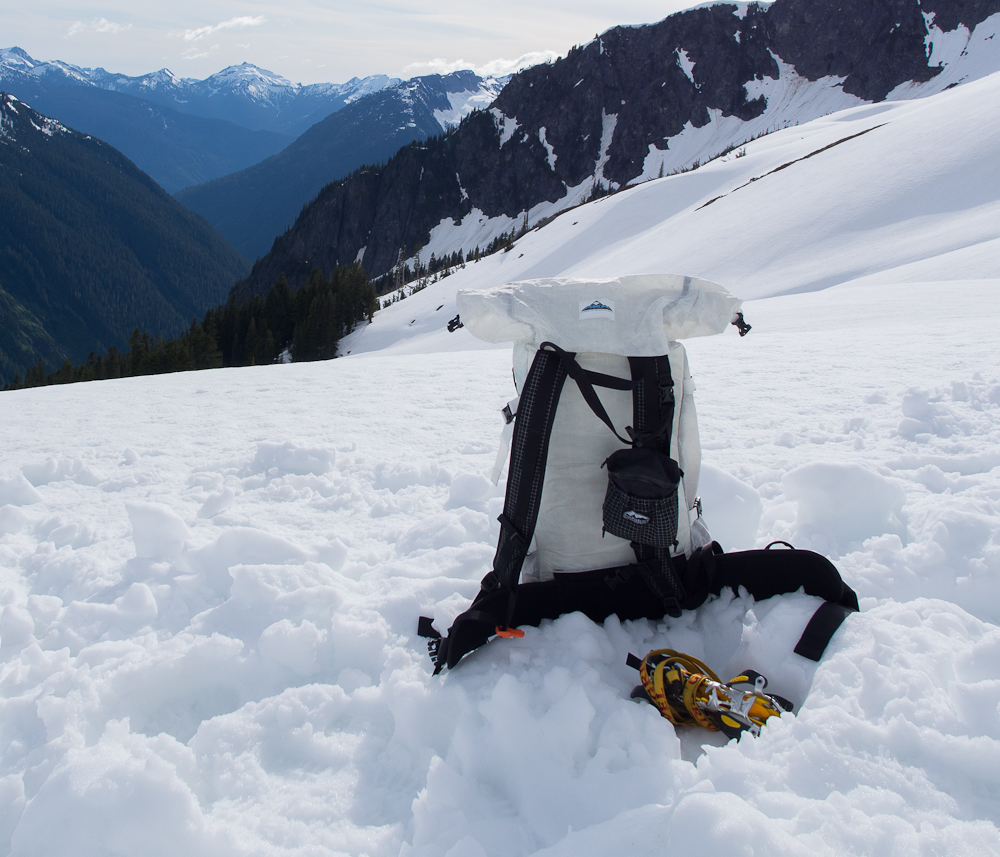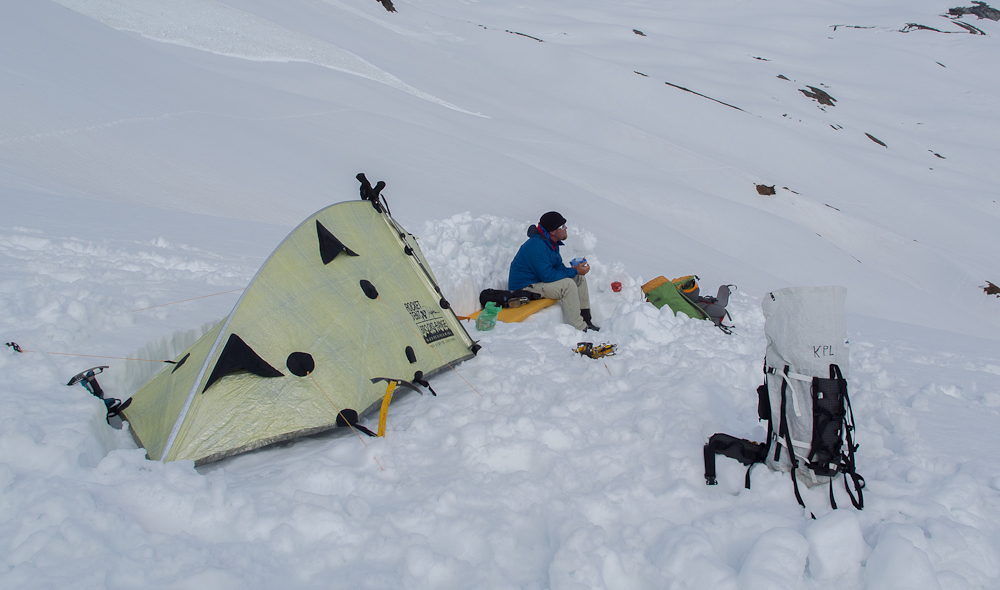
The Hyperlite Mountain Gear Ice Pack is a lightweight alpine pack that I have been using lately for big days and light overnights in the mountains.
The ice pack is about 40 liters (2,400 cubic inches) in capacity, and can hold everything I need for a day of ice climbing or winter alpine climbing day trips. When packing carefully, I have used it on overnight climbs as well.
The Ice Pack is very light weight. In a size large frame, it weighs 2 pounds, 1.3 ounces. It is stripped down to the essentials, with a roll-top closure instead of a lid, and no useless frills. The pack is made from a Cuben fiber material that keeps the weight down.
The suspension on this pack is simple, but very effective. The frame is made from two lightweight aluminum stays, coupled with a lightly padded back panel. The hip belt is also lightly padded, and does a good job of transferring weight to the hips. The suspension allows me to carry loads in the 40 pound range comfortably, and I don’t have aching shoulders, back, or neck at the end of the day.
This pack is different from most in that it does not have “load lifter” straps that run from the shoulder straps to the top of the pack to keep the pack pulled into your back. The Ice Pack relies solely on the shoulder straps to keep the load in balance and snugged tightly to your back. Because of this, getting the right fit is critical. On most packs, the shoulder straps are designed to come a bit below your shoulders, and wrap around them. On this pack, however, you want the shoulder straps to be level with the crest of your shoulders. (Make sure that this is with the pack fully loaded, and with the aluminum frame stays bent to shape.) The Ice Pack comes in 4 sizes to accommodate different back lengths.
With the proper fit, this pack carries really well. With the shoulder straps comfortably snug, the pack sticks to your back like glue, and I haven’t had any issues with the pack shifting around while climbing. I’ve climbed multi-pitch technical rock and ice routes in this pack, and I just forget I’m wearing it. The pack has a couple of side compression straps, which allow for scrunching down the pack to adjust for smaller loads. There is also a very effective top mounted compression strap system that allows you to compress the load from the top. This top compression strap system can also be used for securing a climbing rope. I also use it for strapping on my climbing helmet.
The pack has a number of climbing-specific features that distinguish it from the company’s other pack offerings, which are geared more towards ultralight backpacking. There are well designed ice tool holders that will accept traditional or leashless tools. There is also a crampon patch on the back of the pack, with an elastic bungee cord to hold the crampons on with. I haven’t had good luck with this elastic bungee cord, however. The clip buckles broke almost immediately, rendering the attachment insecure. I eventually just cut off the elastic bungee cord, and replaced it with a couple of pieces of webbing and fastex side release buckles. The pack’s waist belt has sewn on gear loops which are useful for racking gear. You can also add ice screw clippers to the hipbelt for additional ice-screw racking options. When you’re carrying a light load and don’t want the belt at all, you can also strip the waist belt off completely.
My biggest concern when I first got this pack was the lack of a traditional top pocket. In lieu of a top pocket, the pack closes with a simple roll-top closure like that on a dry bag. My habit has always been to store a bunch of stuff in the top pocket, to make it easier to get to during the climb. Initially, I wasn’t sure whether I could live without a top pocket. In actual use, however, I’ve found that I don’t really miss the top pocket. I put stuff I may need while on the route in a separate lightweight ditty-bag that I just keep near the top of the pack. This keeps me organized, and getting to this ditty bag doesn’t take significantly more time or effort than accessing a top pocket.
In actual use, the only feature I really miss on the Ice Pack is a hole in the pack to allow the tube on my hydration bladder to exit the pack. However, I called the good folks at Hyperlite and explained my needs to them, and they agreed to add a hole in the pack above the shoulder strap to allow me easier use of my hydration bladder. (This is one of the reasons I like gear from small companies. They tend to have outstanding customer service and are often willing to go the extra mile to keep their customers happy.)
So far, the Ice Pack appears reasonably durable. After several climbing trips, hikes, and cragging, the fabric shows no real signs of wear. It seems quite well made, with well-constructed seams and reinforced stress points.

The obvious competitors for the Ice Pack are the non-woven dyneema worksacks from Cilogear. I’ve owned and used Cilogear’s 45 liter NWD Worksack for several years now and it’s been my go-to alpine pack due to its light weight and excellent carrying qualities. Some comparisons between the 45L Worksack and the Hyperlite Ice Pack follow:
I prefer the suspension and frame of the Ice Pack. The twin aluminum stays are lighter than the plastic/aluminum frame sheet of the Cilo Gear pack, and still work very well to control the load and transfer the weight of the load to the hips. I feel like the simple, no-load-lifter shoulder strap design of the Ice Pack makes the pack perform better when climbing, and it shifts around less when moving.
The Cilogear’s floating top lid design is more conducive to overstuffing the pack. For times when you want to overload the pack on the approach, the Cilogear pack design allows for greater expansion of volume. The Cilogear is also a larger pack all around (45 liters vs 40 liters nominal volume.) You can overstuff the Cilogear pack to carry 60 liters of more, but this isn’t an option with the Ice Pack.
The Ice Pack is substantially lighter than the Cilo 45L NWD Worksack. The Cilogear pack weighs 2 pounds 11..6 ounces for the pack body, foam-pad, hip belt, lid, and 4 compression straps. The plastic/aluminum frame sheet adds another 16.2 ounces to that total. In contrast, the Ice Pack weighs only 2 pounds, 1.3 ounces including the integral aluminum frame stays.
So, which is better? Well, that depends on how much space I need. If I can comfortably fit my gear into 35-40 liters of space, I prefer the Ice Pack. I think it carries better both on the trail and on the climb and it is lighter. It is the best pack I’ve used so far for light alpine climbing. For day climbs and light overnights, the Ice Pack is my new first choice.
However, for those times when 40 liters isn’t quite enough, I will still be going to my Cilogear worksack. Sometimes, I can’t squeeze all my stuff into 40 liters, and the Ice Pack’s limited expansion capability makes it suitable solely to light and fast endeavors.
One place where the Ice Pack clearly has the Cilogear NWD Worksacks beat is on price. The Ice Pack retails for $260, which is significantly less than the comparable offerings from Cilogear.
Overall, I am extremely pleased with the Ice Pack. For the kind of climbing I like to do, it’s pretty close to the ideal pack.
Note: I initially received an Ice Pack for review free of charge. However, I liked it so much, I went out and bought one with my own money (at retail price,) because I didn’t want to be without it in the event that I was asked to return my review pack.
